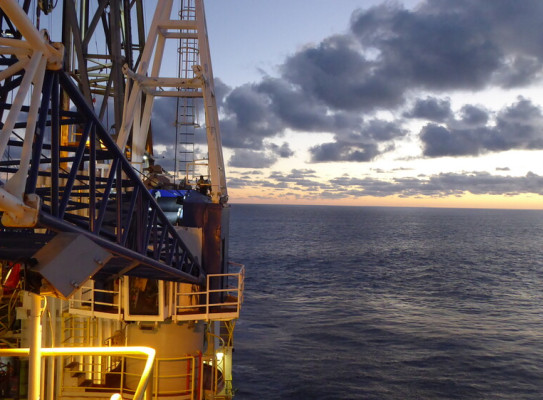
Tipping the balanceWhat makes slow earthquakes episodic

The Hikurangi subduction zone is the focus of GNS Science research on what makes these slow earthquakes episodic.
Overview
Subduction zones, where one tectonic plate descends beneath another, produce Earth’s largest earthquakes and tsunami; but what controls the timing of fault slip in these events?
The recent discovery of frequent, semi-predictable slow-motion earthquakes lasting days to years on subduction faults, provide an untapped opportunity to investigate what tips the balance on these faults, causing them to fail.
The Hikurangi subduction zone lies off the North Island’s East Coast, where the Pacific tectonic plate dives under the Australian plate off the North Island’s East Coast. It is the best place in the world to study slow earthquakes.
Here, slow-motion earthquakes are remarkable for the range of slow and fast seismic slip processes occurring at shallow depths of less than 10km. It offers a globally unique opportunity to resolve processes driving slip on subduction zones using near-field monitoring.
The project was awarded funding by the Marsden Fund in 2020, recognising excellent science with maximum impact for Aotearoa New Zealand.
The project aims to
- detect localised subduction fault changes prior to slow earthquakes, revealing the physical mechanisms that regulate slip timing on a major fault capable of generating devastating earthquakes and tsunami
- determine whether seismologically observed changes in fault properties preceded slip, ultimately enabling future development of more accurate forecasts of both slow and possibly fast (seismic) slip earthquakes
To achieve these objectives we are
- using onshore and offshore sensors coupled with novel geophysical methods to detect high-resolution changes in fault properties leading into an upcoming slow-slip event offshore southern Hawkes Bay, and a recent Gisborne event
The project
Seeking the cause of slow-slip earthquakes
Unravelling the causes of slow-slip earthquakes under the seafloor east of the North Island may lead to more accurate forecasts of big quakes and tsunamis generated by the Hikurangi subduction zone.
The project is applying next-generation techniques to seismic imaging data previously gathered off the southern Hawke’s Bay coast in 2005. The result is a whole new view of parts of the Hikurangi subduction zone. Geoscientists can now better visualise the interface between the Pacific and Australian tectonic plates to find out what’s going on underground.
Subduction zones are the biggest earthquake and tsunami factories on the planet, but we need to first solve the mystery of slow-slip events. These events can release the equivalent of a magnitude 7 earthquake, but over weeks or months. Their discovery 20 years ago has revolutionised seismology and the understanding of fault mechanics.
A supercomputer at the Texas Advanced Computing Center identified patterns in the data enabling scientists to narrow their focus to the physical conditions in the fault where slow-slip events occur.
These slow-slip events are an important part of earthquake cycles because they occur in the same places as large magnitude earthquakes.
What is a Slow Slip Event? – Explanation of slow slip earthquakes associated with New Zealand's Hikurangi Subduction Zone. transcript
What is a slow slip event?
In New Zealand, the Pacific and Australian tectonic plates meet along a series of major fault lines.
In the North Island the Pacific plate dives or subducts westward beneath the North Island's East
Coast along the Hikurangi trough, it forms New Zealand's largest and most active fault the Hikurangi
subduction zone. The plates move towards each other along this fault.
In the deepest parts of the Hikurangi subduction zone the rocks are hotter and the plates can move
past each other's slowly and continuously. But at shallower depths the plates are more brittle and
the friction between them causes them to temporarily lock together.
Over time the stress at the locked zone builds up. Every few years the plates temporarily become
unstuck and a slow slip event occurs, this releases the built-up stress and the Earth's crust rebounds.
A slow slip event is like an earthquake because energy is released along a fault line, but this energy is
released over weeks to months during a slow slip event unlike an earthquake which lasts only a few
seconds. You can see from the GPS sites how the land moves.
Earthquakes on the subduction zone. Sometimes the movements between the plates aren't slow but
sudden and fast, resulting in damaging earthquakes. Large earthquakes can occur on the subduction
zone after the plates have been locked together for a long time, perhaps for hundreds or even
thousands of years.
Over many years of locking enough stress and pressure builds up on the fault that eventually the
fault breaks allowing the plates to suddenly slip past each other in an earthquake.
Can a slow slip event cause a major earthquake?
Slow slip events often occur next to the parts of the plate boundary where earthquakes occur.
Scientists are investigating how a slow slip event can increase stress on the locked segment of the
plate boundary, and whether or not this can influence the timing of future earthquake ruptures.
Once scientists can better understand this relationship between slow slip events and earthquakes,
we might be able to use slow slip events for better earthquake forecasting in the future. However
it's important to know that we have observed dozens of slow slip events in New Zealand that have
not triggered large earthquakes.
Researching slow slip events in New Zealand. Studying slow slip events could tell us a lot about how
and why New Zealand's biggest earthquakes occur.
GNS science geophysicists are working with other international researchers to resolve where slow
slip events happen and what effect they have on the plate boundary fault.
Here you can see a large locked zone covering much of the central and lower North Island, this
locked zone is where pressure and stress are currently building up that could be relieved in a future
earthquake. Next to it is a slow slip zone, and then next to that is a steadily creeping zone.
GNS science is involved in several large international projects to investigate the causes of slow slip
and locking on the subduction zone in New Zealand. Because the Hikurangi plate boundary has
shallower slow slip events than elsewhere in the world making it the best place globally to undertake
this research.
What is a Slow Slip Event?
Explanation of slow slip earthquakes associated with New Zealand's Hikurangi Subduction Zone.
Detecting Slow Slip Earthquakes – The Hikurangi Project is a multinational science investigation of the subduction zone beneath New Zealand's North Island. transcript
As part of a major science project we go out to sea on a research vessel the Tangaroa to deploy
almost 30 instruments out off the coast of Gisborne to measure vertical movement of the seafloor
due to slow slip earthquakes.
Based on the sequence of slow slip events that have happened in the past, we're expecting that
there's likely to be another event happen within the next one to two years.
We have several continuous GPS stations on land but we need more information further out at sea,
closer to where the actual slip is happening.
The instruments measure water pressure which tells us how deep they are below the surface.
Over time we can measure any changes in the vertical position of the seafloor. If it rises the pressure
will decrease and if it drops the pressure will increase. We can measure these changes in height to
within a couple of centimetres.
These instruments we deploy off the side of the boat, we lower them into the water and release
them at the surface. They are weighted so that they'll sink slowly to the bottom, and it will sit there
for between one to two years to carry out the measurements.
While it is sitting on the sea floor, there is a pressure sensor mounted in this bracket here, which is
connected by a cable to a pressure case which is mounted in here. Inside here is mostly full with
batteries as well as some small electronic boards to record the data from the sensor.
On the side here we have glass floats inside these plastic cases. So that when we release these
weights on the bottom, there's enough buoyancy for it to float back to the surface again.
Once the instrument is back at the surface, we then are able to process the data to determine what's
happened over the past one to two years that it's been sitting on the seafloor.
Detecting Slow Slip Earthquakes
The Hikurangi Project is a multinational science investigation of the subduction zone beneath New Zealand's North Island.
Increasing the monitoring sites
Tantalising evidence in recent years suggests a build-up of fluid pressure near the fault exerts a major control on timing of slow-slip quakes in New Zealand. Monitoring pressure accumulation in the fault may enable better forecasting of slow, and possibly, fast earthquakes in the future.
Is fluid change in the fault a symptom or the cause, or is it the steady build-up of stress from tectonic plate motion? To help find the answer, scientists have mounted a large-scale deployment of undersea and land-based monitoring instruments in southern Hawke’s Bay and Wairarapa. They will monitor changes before, during and after a regularly recurring slow-slip event expected offshore sometime before 2023.
The project is forging new ground in seafloor geodesy and will help put New Zealand at the forefront of global efforts to monitor offshore faults that can generate large quakes and tsunamis.

Research project details
Collaborators: Dr Katrina Jacobs: GNS Science; Dr Emily Warren-Smith: GNS Science; Associate Professor Pascal Audet: Department of Earth and Environmental Sciences, University of Ottawa, Canada; Associate Professor Kimi Mochizuki: Earthquake Research Institute, University of Tokyo, Japan (ERI); Professor Demian Saffer: University of Texas Institute for Geophysics (UTIG), Austin, Texas, USA; Professor Martha Savage: School of Geography, Environment and Earth Sciences, Victoria University of Wellington, New Zealand; Professor Spahr Webb: Lamont-Doherty Earth Observatory, Columbia University, USA
Duration
Funding platform
Marsden Fund
Status
Programme leader
Dr Laura Wallace, GNS Science